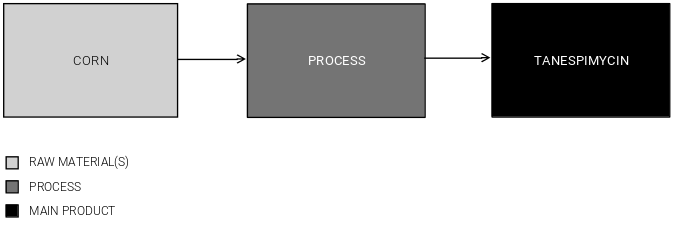Commodity Production Costs Report
Tanespimycin Production
Tanespimycin Plant Capital & Operating Cost Analysis | United States | Q3 2025
This report presents the economics of Tanespimycin production from corn. The process examined is a typical fermentation process. In this process, corn starch is initially converted to glucose by alpha amylase. The glucose is then fermented to geldanamycin intermediate, which is purified and converted to Tanespimycin product.
The report provides a comprehensive study of Tanespimycin production and related Tanespimycin production cost, covering three key aspects: a complete description of the Tanespimycin production process examined; an in-depth analysis of the related Tanespimycin plant capital cost (Capex); and an evaluation of the respective Tanespimycin plant operating costs (Opex).
The Tanespimycin production process description includes a block flow diagram (BFD), an overview of the industrial site installations, detailing both the process unit and the necessary infrastructure, process consumption figures and comprehensive process flow diagrams (PFD). The Tanespimycin plant capital cost analysis breaks down the Capex by plant cost (i.e., ISBL, OSBL and Contingency); owner's cost; working capital; and costs incurred during industrial plant commissioning and start-up. The Tanespimycin plant operating costs analysis covers operating expenses, including variable costs like raw materials and utilities, and fixed costs such as maintenance, labor, and depreciation.

Product
Tanespimycin. Tanespimycin is a water-soluble benzoquinone antineoplastic antibiotic. It acts as an inhibitor of Hsp90, a heat shock protein that plays a central role in promoting the functionality and stability of a group of proteins associated with cancer. Tanespimycin is a derivative of geldanamycin, an antibiotic that is being studied in the treatment of cancer and patients with certain types of leukemia or solid tumors, especially kidney tumors.
Raw Material
Corn. Corn is available at relatively low and steady prices, it has high starch content, is easily stored, transported and handled. Such characteristics led naturally to the development of several processes to recover its starch and to process it into several industrial products. Most industrial processes make use of the shelled corn, which has been stripped from the cob during harvesting. The shelled corn is converted to other products through milling and refining. Corn milling processes can be divided in two main groups, wet milling and dry milling. In the wet milling, the corn kernel is milled in such a way that its components can be separated in an aqueous medium. In the dry milling the components of the kernel are separated using screening and air classification, but the fractionation is less efficient. Wet milling is generally used to produce high quality corn starch at high yields along with its by-products used in the animal feed (corn gluten meal and corn gluten feed) and food (corn oil) industries. Dry milling is widely used in the production of fuel Ethanol by fermentation of raw corn starch, other uses include the brewing and cereals industries.
Report in PDF Format
Download & Explore Anytime
Access in Various Devices
Print & Read Comfortably
Share With Co-workers
Up-to-date Report
Professional report based on Q3 2025 economic data, ensuring timely evaluations.
Multiple Use Cases
Ideal for investment screening, feasibility studies, cost estimates, and research planning.
Proven Methodology
Developed using a consistent methodology honed over a decade, ensuring reliable cost analyses.
Report Editions
Content Highlights
Plant Capital Cost Summary
Summary outlining the capital cost required for building the Tanespimycin production plant examined.
Plant Capital Cost Details
Detailing of fixed capital (ISBL, OSBL & Owner’s Cost), working capital and additional capital requirements.
Plant Cost Breakdowns
Breakdown of Tanespimycin process unit (ISBL) costs and infrastructure (OSBL) costs; plant cost breakdown per discipline.
Operating Costs Summary
Summary presenting the operating variable costs and the total operating cost of the Tanespimycin production plant studied.
Operating Cost Details
Detailing of utilities costs, operating fixed costs and depreciation.
Plant Capacity Assessment
Comparative analysis of capital investment and operating costs for different Tanespimycin plant capacities.
Production Process Information
Block Flow Diagram, descriptions of process unit (ISBL) and site infrastructure (OSBL).
Process Consumptions
Raw materials and utilities consumption figures, by-products credits, labor requirements
Process Diagrams
Process flow diagrams (PFD), equipment list and industrial site configuration
Could Not Find the Report You Need?
Obtain a Bespoke Report
Get a report targeting the process in which you are interested
See Offer Details
Understand Bespoke Reports and how you can easily order them
Check Editions & Pricing
Complete a brief form and see a quotation for your Bespoke Report
Other Related Production Cost Reports

Polylactic Acid Production from Corn
This study approaches the economics of Polylactic Acid production from corn in the United States. Initially, shelled corn is passed through a wet milling process to form corn starch, which is hydrolyzed to dextrose. Then, dextrose is fermented into lactic acid in a process similar to Cargill process. Finally, lactic acid is polymerized using a melt-phase polymerization process similar to the one proposed by NatureWorks.
Details: 140 kta United States-based plant | Q3 2025 | 107 pages | Issue D | From $1,499 USD

Ethanol Production from Corn Dry Milling
This study presents the economics of hydrous Ethanol production from corn in the United States using a typical dry milling process. Initially, corn is ground, slurried with water and then submitted to enzymatic hydrolysis, which convert starch to glucose. Next, the glucose is fermented to Ethanol by yeasts, yielding Hydrous Ethanol.
Details: 300 kta United States-based plant | Q3 2025 | 107 pages | Issue C | From $799 USD
+800 Reports Developed, Targeting +250 Commodities
Vast Report Library
858 independent and up-to-date reports examining embryonic and established production processes.
Free Sample Reports
Quickly understand the structure and depth of content of our professional reports.

